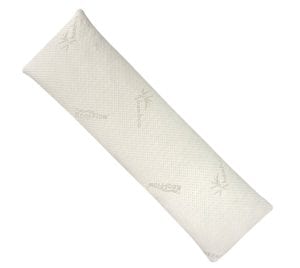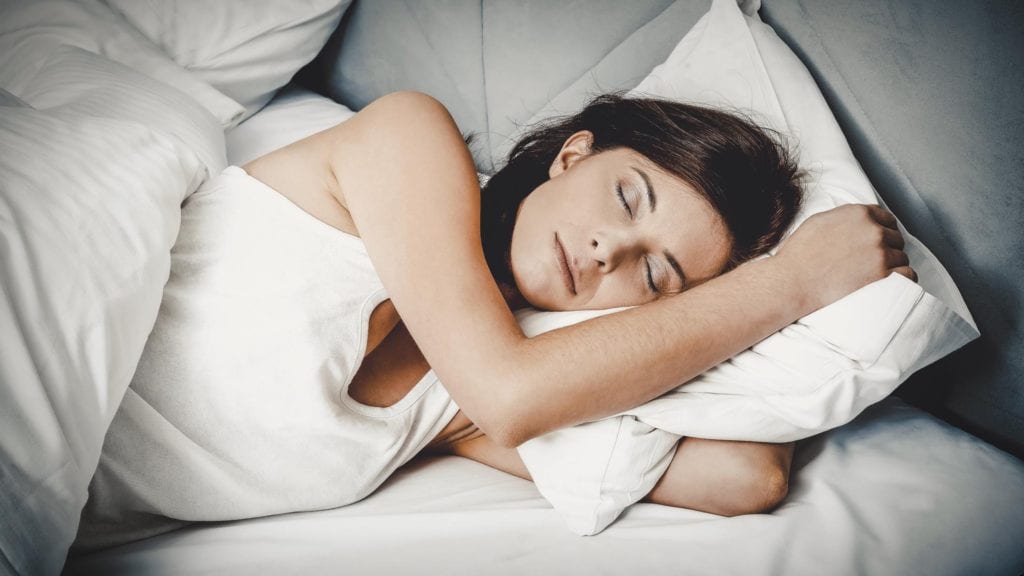
Where to Lay My Head?
We’ve come a long way from when anything you grabbed to put under your head when sleeping was your pillow. The arms and hands would do until they were moved. A rolled up garment was much better. A classic story is of Jacob, a fugitive who slept with his head on a rock. Ancient Egyptian nobles had curved wooden headrests. Today, we have specially made pillows, which are essentially sacks filled with cushioning materials and sewn (or zipped) shut.
Be sure to check out our articles on pillow reviews, ratings, certification, pillow material and more…
Functions of the Pillow
A pillow serves two basic functions, for health and for comfort. According to Dr. Rick Swartzburg, sleep product designer for Selectabed [1], “A pillow should function to provide for support for both the head and neck, while enhancing the comfort in order to allow for a deeper and more restorative sleep.”[2]
The first function of a pillow is vital to spinal health. As it conforms to the neck and head, it provides orthopedic support, keeping the neck in line with the rest of the spine. The backbone (spine) naturally curves between the front and the back, but it is supposed to be in the same plane, lined up side-to-side. Viewed from the front or back, this should be a straight line when at rest. This explains how a person could sleep soundly with a hard object for a pillow or headrest – it kept the neck in line.
Pillows for other parts of the body also serve the function of aiding in proper spinal alignment as it is affected in those locations, which can also influence digestion and breathing. Sleep apnea[3] and snoring[4] may be treated with pillows holding the sleeper’s head and upper body in a way that keeps the airways and nasal passages open. Pillows can also elevate the feet for better circulation, support the lumbar, and control pelvic rotation [5].
The second function is comfort. For persons with normally aligned spines, the neck is more comfortable when properly lined up with the back. In this case, comfort equals health, since deep sleep is essential to good health. But the pillow adds additional comfort by cushioning the head. Anyone who has had a migraine can appreciate that.
All the other functions of pillows are ways to fulfill these basic functions of support and comfort.
Types of Pillows
There are several types of pillows, which may be classified by specific function or by materials. The two lists form a matrix, in which the pillows can be classified by function then sorted by material, or classified by material then sorted by function. Here we will focus on functional classification.
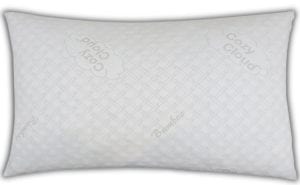
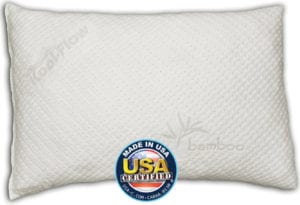
Pillows for the Head
This is the classification we most often associate with pillows. Whatever kinds of pillows a person may use, at least one (usually) supports the head. Proper neck alignment is essential to good spinal health and health in general. How thick and soft the pillow is depends largely on the seeping position. For stomach sleepers, Dr. Swartzburg says, “The pillow will need to be very pliable and thinner to prevent your head from having to tilt backwards into too much extension and used more to wedge your whole upper body, so your neck will not be in such a drastic state of rotation to one side.” A rectangular head pillow can be turned so that one end is under the collarbone and shoulder.
A back sleeper needs a pillow just thick enough to keep the head from tilting too far back. Sinking into the pillow a bit will keep the head from rolling to the side.
Side sleepers need a pillow thick enough to make up for the width of the shoulder (the distance from the ear to the tip of the shoulder). Dr. Rick Swartzburg says, “If you are a side sleeper, a good pillow will need to keep your spine from deviating laterally (bending to the up side or down side). A side sleeper will need to make sure that the pillow is pulled down to the tops of the shoulders in order to prevent a loss of support at the base of the neck, which would cause the head to tilt upwards, while the spine bends downward.”
Dr. Swartzburg created the Snuggle-Pedic [6] pillow to allow for all three different types of sleepers, with its inherent ability to properly contour and self-adjust to the sleeper’s position, and the ability to be easily customized.
Most head pillows are rectangular, though some persons prefer square ones. The classic pillow shape is a 1:1.3 ratio rectangle (standard size = 20” x 26”). Other pillow sizes are Queen (30” long), and King (36″) [7].
Contour pillows are designed to cradle the head and support the neck at the same time. The head rests in the trough, while the smaller ridge fits under the neck for a back sleeper, and the larger ridge is for a side sleeper if on a firm mattress. The smaller ridge will work for the side sleeper if on a memory foam mattress, which allows the shoulder to sink in.
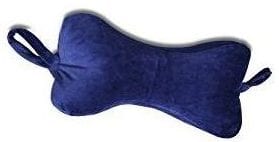

Pillows for the Neck
Some pillows are designed specifically to support the neck, and are often prescribed for neck pain[8]. They are narrow enough to fit between the lower part of the skull and the shoulders. Three common shapes for neck pillows are bolster (log-shaped)[9], horseshoe and dog-bone.
Pillows for the Back
The most common back pillows are for the lumbar, which are usually long and narrow, often a bolster or half bolster. A lumbar pillow fits across, side-to-side, under the small of the back. This is to support a recessed area of the back while muscles are relaxed. Used for both side sleepers and back sleepers, a lumbar pillow is often used for back pain.[10]
Also used for the back are wedge pillows. A large wedge pillow raises the upper body. This relieves strain on the lower back while also elevating the head to treat sleep apnea and stop snoring. A smaller wedge pillow can be used by stomach sleepers under the body on the side toward which the head is turned. This is to keep the body from rolling that direction, putting more stress on the neck.
Not all back pillows are for sleeping. Some, such as the The BackForm™ Adjustable Memory Foam Seat Cushion[ [11], are for sitting. They both cushion the back and support the lumbar.
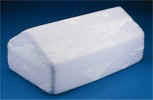
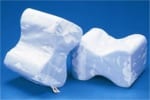
Pillows for the Legs and Feet
Wedge pillows are also used to elevate the legs and feet. The primary advantage of this is that it makes it easier for blood to return to the heart. When a person is walking and otherwise moving around, leg muscles pump blood through the veins. When the person is inactive, as when sleeping, the heart has to do all the work, making leg elevation advisable for those with circulatory problems to prevent deep vein thrombosis.
Other kinds of pillows for the legs are knee wedges[12] and leg spacers[13]. According to Dr. Swartzburg, elevating the knees with a knee wedge reduces spinal pressure from the Psoas muscles, and leg spacers keep the pelvis from rotating when sleeping on one’s side.
Pillows for the Whole Body
Body pillows have gained in popularity, as a search on Amazon[14] will show. This includes the top-rated Snuggle-Pedic Body Pillow[15]. These can be used for any sleeping position, but they are most beneficial first for stomach sleepers, then for side sleepers. A body pillow is especially recommended for pregnant women sleeping on their sides.
Next
The next article in this series is Filling Materials in Pillows, Part 1 of “Pillow Materials.” This includes natural ingredients, latex, and memory foam, among others.
Check out some more articles on pillow reviews, ratings, certification, pillow material and more!
End notes and Sources
- Selectabed, https://memoryfoammattress.org/selectabed/
- Email message (08/11/2017), Dr. Rick Swartzburg is a licensed Doctor of Chiropractic and sleep product designer for Selectabed, the company that he heads up at Relief-Mart, Inc.,
- Memory Foam Mattress.org, “Sleep Apnea and Hypopnea” (10/10/2016), https://memoryfoammattress.org/sleep-apnea-and-hypopnea/
- Memory Foam Mattress.org, “Snoring Solution: Look to the Pillow” (10/10/2016), https://memoryfoammattress.org/snoring-solution-look-to-the-pillow/
- Dr. Rick Swartzburg, “Leg Spacer, A Doctor’s Perspective,” Relief-Mart, Inc. (n.d.), https://www.reliefmart.com/pillows-and-sleeping-support-products/leg-spacer-lower-back-support-for-side-sleep/
- Snuggle-Pedic, Bamboo Combination Memory Foam Pillow with Adjustable Fit (n.d.), http://snugglepedic.com/snuggle-pedic-bamboo-pillow.html
- The Bedding Site, “Pillow Sizes” (n.d.), http://www.thebeddingsite.com/pillow-sizes.aspx
- Memory Foam Mattress.org, “Pain in the Neck” (11/18/2016), https://memoryfoammattress.org/pain-in-the-neck/
- Relief-Mart, Cylinder Bolster Pillow™ (n.d.), https://www.reliefmart.com/pillows-and-sleeping-support-products/memory-foam-bolster-pillow/
- Memory Foam Mattress.org, “Back Pain, Mattresses, and Cushions” (10/29/2016), https://memoryfoammattress.org/back-pain-mattresses-and-cushions/
- Relief-Mart, The BackForm™ Adjustable Memory Foam Seat Cushion (n.d.), https://www.reliefmart.com/adjustable-back-support-braces/the-backform-lumbar-support-seat-cushion/
- Relief-Mart, Knee Elevating Wedge (n.d.), https://www.reliefmart.com/pillows-and-sleeping-support-products/knee-elevating-wedge/
- Relief-Mart, Leg Spacer (n.d.), https://www.reliefmart.com/pillows-and-sleeping-support-products/leg-spacer-lower-back-support-for-side-sleep/
- Amazon, Search: “body pillow” (08/12/2017), https://www.amazon.com/s/ref=nb_sb_noss_1?url=search-alias%3Dgarden&field-keywords=body+pillow&rh=n%3A1055398%2Ck%3Abody+pillow
- Amazon, Snuggle-Pedic Shredded Bamboo Combination Memory Foam Body Pillow With Kool-Flow Cover (08/12/2017), https://www.amazon.com/Snuggle-Pedic-Combination-Body-Pillow-Kool-Flow/dp/B011U1LIK8/ref=sr_1_2?s=home-garden&ie=UTF8&qid=1502561018&sr=1-2-spons&keywords=body+pillow&psc=1

